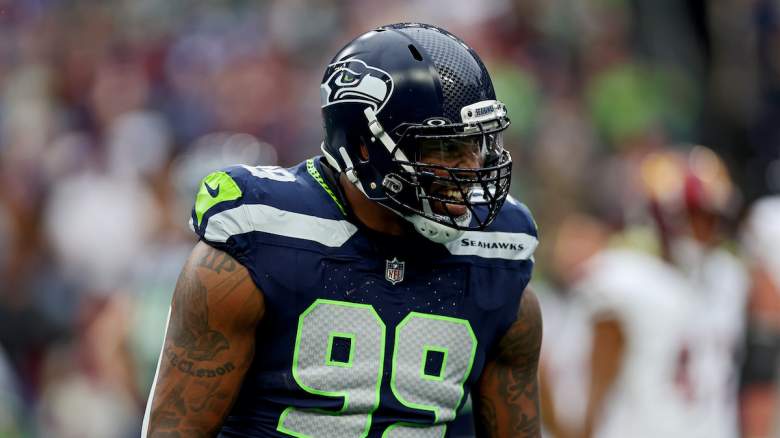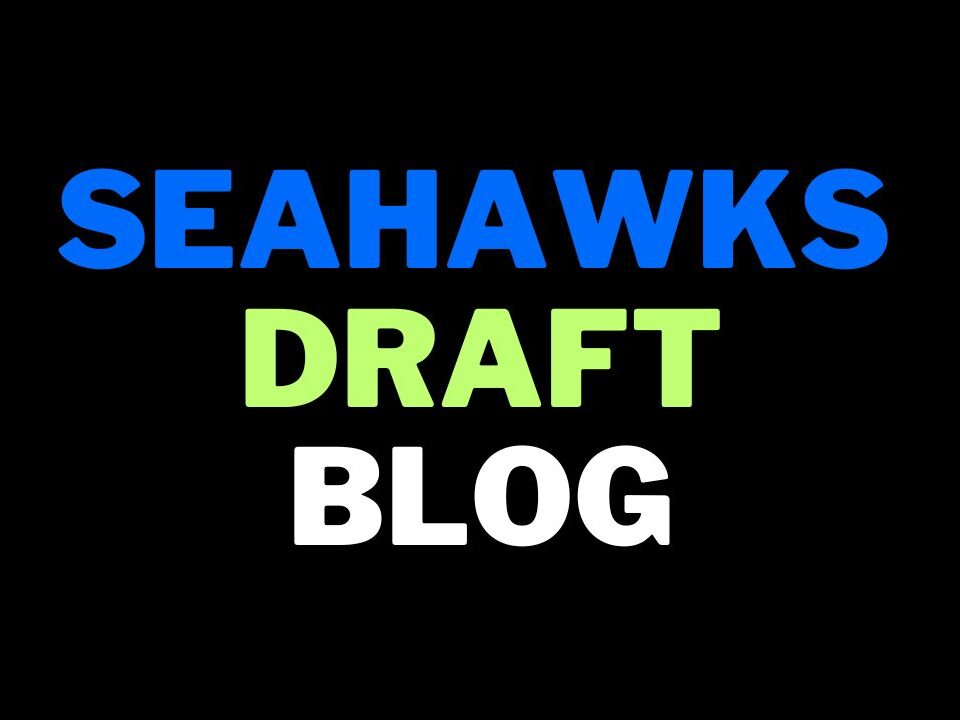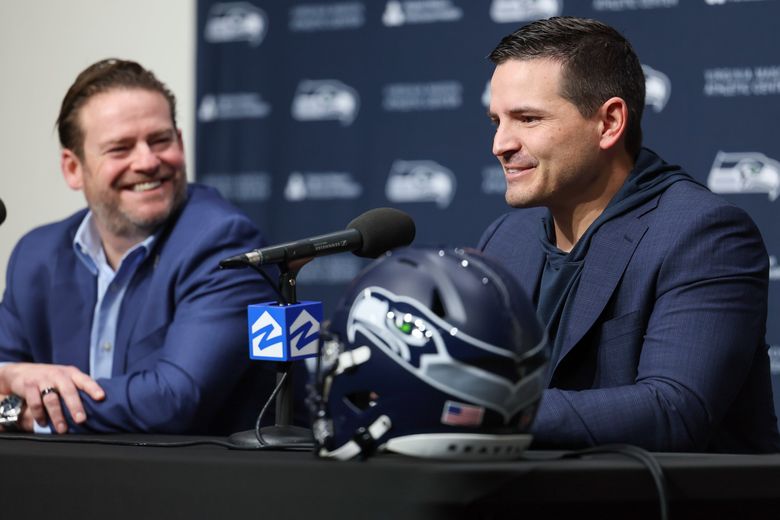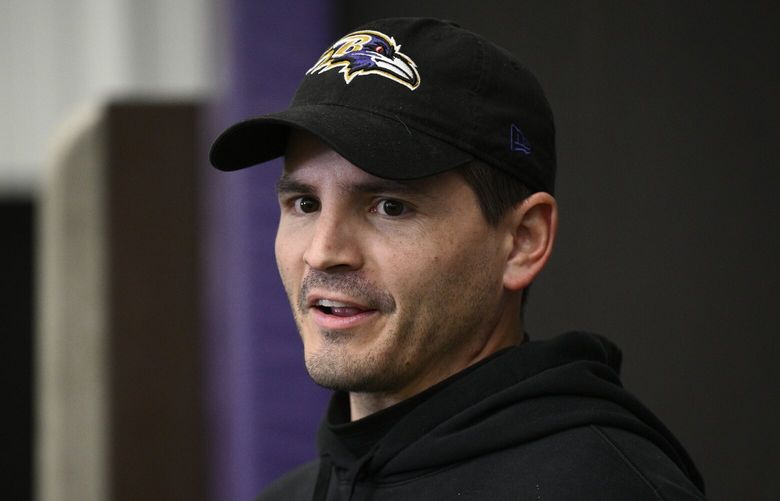
Here are a few ideas kicking around in my head as the Seahawks start a new era under John Schneider and Mike Macdonald. I’ll touch on roster moves, free agency and the draft. I reserve the right to change all of these projections!
The need to create cap space
This is the first thing on the agenda. The Seahawks are projected to be $9.5m over the cap, in effective cap space, for 2024. They cannot function without making big savings and freeing up significant cap room, meaning difficult decisions need to be made.
Two Post-June 1st cuts
The Seahawks will almost certainly designate Jamal Adams as a post-June 1st cut. That spreads the dead money out over two years ($10.4m in 2024 and 2025) and immediately creates $16.5m.
The second cut is more painful. Tyler Lockett has been a tremendous servant to the Seahawks. I’ve gone back and forth on this one but his cap hit of $27m is just too big. The fact he has a similar cap hit in 2025 makes it difficult to lower his salary, without making long term commitments in a new deal. Designating Lockett as a post-June 1st cut creates $9.9m in dead money this year and next but saves the team $17m.
These two moves would create a situation where the Seahawks have $24m in effective cap space (money they can spend).
Parting with Adams feels inevitable. Lockett would be more significant. However, with another deep receiver class in the draft, there will be an opportunity to get a cheaper replacement who can operate as a WR3.
You might ask whether they can trade Lockett. Not before June 1st, because they’d only save $8m and would take on a $19m dead cap hit. Given the need for immediate relief, it’s more likely they’d have to go the post-June 1st route.
Further cuts to create cap space
Bryan Mone will almost certainly be cut to create an extra $5.3m. It’s possible they cut Nick Bellore to create another $2.8m — that’ll depend on whether Schneider values his special teams impact as much as Pete Carroll. These two further moves would give the Seahawks $32.1m to spend — a reasonable amount given the challenges ahead.
Players who won’t be cut
I don’t think Will Dissly will be cut before the draft. Both Noah Fant and Colby Parkinson are free agents. Retaining one tight end on the roster feels necessary, then you can reassess down the line. There’s no financial difference between cutting Dissly in March or July, so provided you create enough space elsewhere, you can retain him. If they did cut Dissly because of his $10m cap hit, I think they’d try to re-sign him anyway.
I also don’t think Quandre Diggs will be cut before the draft. His obscene cap-hit of $21.2m is a problem but the Seahawks probably need to at least keep Diggs and Julian Love on the roster pre-draft, in order to not feel forced into a corner at the position. After the draft, parting with Diggs to create $10m in cap space is plausible if they feel comfortable with the position. This situation would be different, of course, if they prefer to try and sign a safety in free agency (eg Geno Stone). In that instance, Diggs would likely be gone. Transferring one big salary at safety for another, though, feels like bad business. They’re better off trying to find their own, cheaper version in the draft.
Spoiler alert — in my next horizontal board, I will have Wake Forest safety Malik Mustapha as my top ranked player at the position with a second round grade (with the expectation he’ll be available later than that).
What happens with Geno Smith?
I think anything’s on the table but I also think there are a few things that could be steering us towards the way this is heading.
Firstly, I keep reading and hearing people say that his cap hit in 2024 ($31.2m) is fair market value and works alongside, for example, his PFF grade at the quarterback position compared to the rest of the league. I don’t think this is the right way to approach this topic. These are the two main things to consider.
Firstly, what does Schneider think about the talent difference between Smith and Drew Lock? Not what you think, what Schneider thinks. If Lock costs, say, $6m for next season and Smith costs $31.2m, is that discrepancy in price worth it in the mind of the man actually making the decision?
I think there’s some evidence suggesting he doesn’t think the difference is worth it. Schneider was lukewarm about Smith in his solo press-conference, discussing how he’d had two mixed seasons with highs and lows. He didn’t say anything about the upcoming season (eg, ‘we’re looking for more consistency next season’) which would be a clear indicator that he’s part of their plans. He could’ve made reference to Smith being ‘their guy’ or just used some platitudes to offer praise. Instead, he gave an extremely non-committal answer.
Macdonald was also non-committal while name-dropping Lock (a free agent) a couple of times during his press conference, unprompted. The fact that Macdonald mentioned Lock, who would need to be re-signed, felt like a tell to me.
Secondly, it’s plausible Schneider intends to draft a quarterback this year. If that is their plan, having a cheaper bridge isn’t unreasonable if they want to give the rookie every opportunity to win the job this year.
There could be some benefit to that. If 2024 is about transitioning under a new Head Coach after 14 years, why not let a rookie take his growing pains with the hope that everyone comes out stronger for 2025 and beyond? It’s not unheard of for a new regime to begin by drafting a QB. They spent the last two years, after all, building a foundation. So he wouldn’t be coming into a hopeless situation.
I also think it’s possible they re-sign Lock and bring back Geno, albeit after reducing his 2024 cap-hit because as we keep mentioning — the Seahawks need to create cap space. Let’s review the options with Smith, courtesy of Curtis Allen’s excellent breakdown of the situation:
As the table shows, they can realistically lower his cap-hit by $4.8m or $5.5m without significant dead-cap damage down the line, by converting roster bonus money and salary. The question remains, though, does Schneider believe a $25-26m cap hit for Smith is still better value than Lock on far less, especially if he intends to draft a quarterback?
If they intend to part with Smith they basically have two options. Cut him before February 16th or trade him before March 20th. Those two options will create $13.8m in cap space.
I think both are on the table. It’s possible the February 16th date is going to come too soon for clarity to be established on what’s the right thing to do. They don’t even have an offensive coordinator yet. I also think Smith is too good to just discard. Thus, I think he’ll still be on the roster beyond that day.
The new league year starts on March 15th meaning they’d have ample opportunity, including at the combine, to discuss trade scenarios. Having a hard deadline of March 20th before Smith’s guarantees kick-in will give the Seahawks a major leverage headache in talks. However, two things ring true. One, there are a lot of teams who need a viable quarterback option in 2024. Two, Smith is good enough to start somewhere this year.
If, after the combine, teams like Pittsburgh, New England, Atlanta, Las Vegas and Washington feel less confident about their draft options (or simply desire a bridge to a rookie) they might be prepared to make an offer. The Commanders have $62m in effective cap space, the Falcons have $20m, The Patriots $57m and the Raiders $31m. They can all realistically fit Smith into their budget. The Steelers are $19m in the red for effective cap space but have several levers they can pull to create room.
You won’t be able to drive a hard bargain because of the financial time constraints and the March 20th deadline before Smith’s contract is locked into Seattle’s budget. It’s possible, though, that they might be able to get a fourth or fifth rounder in return. That’d be better than nothing if the Seahawks’ intention is to go with Lock and a rookie anyway.
Of course they could also decide to roll with Smith but in order to do this, I think they’d almost certainly look to re-work his contract. From the minute he signed his deal, it screamed ‘they will do something next year’. Now we’ve reached that point. I think Schneider is simply preparing this team to cross to a younger quarterback, sooner rather than later. So the price of a bridge, and how he personally rates Smith vs Lock at their respective prices, will likely be the determining factor on what decision is made.
Another potential trade candidate
Dre’Mont Jones was a disappointment in his first year in Seattle. His contract is not too restrictive. If, later in the summer, they wanted to move him for a throwaway pick — they can create $11.5m in cap space. Again, this is probably one where they see where they are after the draft. By training camp, if they like their D-line depth, it’s possible they send him to another team. Remember — the Ravens signed Jadeveon Clowney in August and Kyle Van Noy in September. Having cap space later in the year to be active could help the Seahawks find similar value to aid their new Head Coach.
Who will they re-sign?
Jeff Howe from the Athletic is already reporting the Seahawks and Leonard Williams are hoping to get a deal done to keep him in Seattle. This is a no-brainer for the Seahawks. It might cost them approximately $17m a year but if they were willing to spend that kind of money on Dre’Mont Jones, they have to be willing to do it for Williams.
It’d significantly eat into Seattle’s available cap space — which is why they might have to make some difficult decisions on the likes of Smith, Lockett, Dissly and Diggs. They can’t fudge this re-shape under Macdonald and need to be ruthless. The aim is to craft a great team, not a ‘good enough not to be awful’ team. Williams can help them get to where they want to go as an impact player.
The defense in Baltimore relied a lot on the strong performances of Roquan Smith at middle linebacker. Given the lack of star options in the draft at MLB, I think the chances are they’ll look to re-sign Jordyn Brooks and incorporate him into that role. I’m not sure he’ll break the bank and they might be able to get him on a one or two-year deal so both parties, under the new regime, can assess fit.
I think the Seahawks will look to re-sign Noah Fant but it will depend on cost. Schneider was willing to draft him in the first round in 2019 so he’s clearly a fan and probably feels the Carroll regime, as with D.K. Metcalf, didn’t do enough to get the most out of Fant. He retains untapped potential and it’s hard to see how they will upgrade from him in the draft or free agency. Again though, it’ll depend what his market is.
I don’t think they will re-sign Bobby Wagner. For players like Damien Lewis and Evan Brown, it’ll likely come down to how cheap they are.
How will they approach free agency?
I think anyone expecting any big splashy moves will be disappointed. From what I can gather about the Ron Wolf philosophy, as noted in this article, the building of this team could be focused through the draft and any outside moves will be more calculated than splashy. Plus, that is how the Raves have operated too.
I don’t expect the Seahawks to go big game hunting for Patrick Queen, Justin Madubuike or Geno Stone. Madubuike will likely be franchised anyway.
I think the Seahawks will return to the approach of letting the market come to them. They’ll check the second and third wave of free agency and seek value.
The core of the team is going to be built through the draft. I don’t think they’re going to even attempt to transplant Baltimore to Seattle. They are going to create their own spine, some of the pieces of which are already in place. I think anyone who comes over from the Ravens will be due to opportunity and value, not because the Seahawks out-spent everyone else.
Will they draft a quarterback?
I think there’s a very reasonable chance they will. It’s been so long. This is John Schneider’s show now and I don’t think he’s going to ‘get by’ at the position. I think the Geno Smith plan was very much a Pete Carroll project, perhaps tied to the need to have a veteran starter vs a rookie given the nearing end of Carroll’s contract.
Schneider is now building the future of the Seahawks. He can afford to think long term. He’s always said his intention was to draft a quarterback most years. We’ll soon find out whether, when in charge of the whole operation, he’s prepared to do that.
There are some things to remember here. Firstly, as we noted in a recent article, Schneider reportedly wanted to draft Andy Dalton in the first round in 2011. I remember scouting Dalton at TCU. His career played out exactly as you can imagine based on what he showed in college.
It’s indicative of his willingness, perhaps, not to necessarily seek perfection. Dalton had reasonable tools, the ability to get the ball downfield, a long college career where he elevated his team and lots of production. He played in an aggressive, pass-heavy offense.
In this draft there are players who fit that mould in Bo Nix and Michael Penix Jr. They could be available in the same kind of range (#25) Schneider was prepared to draft Dalton. I don’t think it’s out of the question he will look to trade down, to try and get back into round two, before drafting a quarterback. Nix is a physical prototype and Penix Jr has an outstanding arm and can be very aggressive with his targets. These are things Schneider, I think, will value.
I also think Spencer Rattler has qualities that will appeal to Schneider, plus J.J. McCarthy has been around Mike Macdonald at Michigan, so they’ll have good intel there. I think there’s a very realistic chance the Seahawks draft one of these players.
There are other things to consider too. Schneider was in Green Bay when they took Aaron Rodgers with the 24th pick. That was an opportunistic pick, and a shot to eventually replace Brett Favre. Here’s what scouts were saying about Rodgers before the 2005 draft:
“He’s a little short. The thing you worry about is those (Jeff) Tedford guys. They don’t do anything for a couple years and then they have a good year or two. Who of his quarterbacks has done what they’re supposed to do? None of them. Is he just working magic with great college quarterbacks or just manufacturing guys?”
“I like him. He’s a very talented guy. A lot of quarterbacks that were system people have not done very well. That puts up a red flag. Not that he is one of them. He could be an exception. But I can’t get it out of my craw.”
“I like him. I just don’t know if he’s maxed out. He’s more accurate than (Kyle) Boller but probably not as athletic. He’s a better player than Akili Smith. He’s more athletic than (Trent) Dilfer was. He’s a little more mobile than Joey Harrington. He had to go to a JC because no one would recruit him because they said he was too small. He’s been busting his (expletive) his whole life to get to this point. I just don’t know how much more he has to give.”
“I think he has some upside although there are some things that are just ordinary about him.”
“The guys that Tedford has had, what have they developed into? They’re too well-schooled. So mechanical. So robotic. I don’t know if they become good pro players. I think Rodgers is in that same mold.”
As you can see, not glowing reports and why he ultimately dropped. Green Bay capitalised. I’m sure Schneider will be mindful of stuff like this, waiting for an opportunity to similarly focus on what a player ‘can be’ not what he isn’t currently (a key Ron Wolf philosophy).
Despite drafting Rodgers, the Packers then drafted Brian Brohm in the second round in 2008. Again, they were taking shots. Buying as many raffle tickets as possible, as Schneider has said is his ideal approach to the position. It’s not unreasonable to think Schneider could take a quarterback early this year (first three rounds) and do the same next year as he tries to find a long-term top-level solution, now that he’s fully in charge.
Here’s another Packers-related note. Although this only took place recently, long after Schneider had departed Green Bay, their decision to draft the ‘floored but with upside’ Jordan Love is indicative of the Packers DNA. Again, planning ahead (Rodgers still on the roster) and buying into what a player can become. I am not convinced Schneider is solely focused on only drafting the perfect QB. I think, like Green Bay, he’s going to look for opportunities and value.
The Ravens, where Macdonald’s DNA was formed, have also done this. They won a Super Bowl after drafting Joe Flacco, from small school Delaware, with the #18 pick. They also drafted Lamar Jackson with the 32nd pick. Both Schneider and Macdonald have come from backgrounds where their previous teams have enjoyed great success drafting quarterbacks outside of the top-10.
Macdonald might be a defensive coach but I wouldn’t put it past the Seahawks to invest in a young quarterback with the first or second pick of this new era.
How will they approach the draft?
Let’s park the quarterback talk for the moment. At #16 I think there will be a selection of players who, if available, they might be willing to stick and pick. It’s still very early but I would suggest names like Taliese Fuaga, Jared Verse, Chop Robinson and J.C. Latham could fit into that category. Otherwise, trading down into the 20’s could potentially net the Seahawks a second rounder. Per the draft trade chart, the #16 pick is worth 1000 points. Green Bay’s pick at #25 is worth 720. The Packers have two second round picks, including #57 overall (worth 330 points). There could be a deal to be done here, especially if a left tackle is still available at #16 (a huge need for Green Bay).
There will still be good options in the 20’s such as, potentially, Troy Fautanu, Jackson Powers-Johnson, Graham Barton, Darius Robinson and others. Plus, this could be the range where you target a quarterback.
I think they will believe they can address multiple needs in this draft by finding ‘their’ players, thus justifying the trade down if a top prospect isn’t available. I think they will see this as an opportunity to further build a foundation, with real value to be had between rounds 2-4.
For example — there aren’t any linebackers slated for round one but there are good, rounded players who are projected to be available in the second, third or fourth round. It’s a deep class of receivers, which makes it easier to replace Lockett if he departs (Luke McCaffrey reminds me so much of Lockett). There are a lot of good offensive linemen and some depth across the defensive line too.
As for safety — as noted earlier, when I release my new horizontal board, Wake Forest’s Malik Mustapha will be the top ranked player at his position. I think he’s a second round talent who could be available in round three. His combination of speed, physicality, range, hitting, run defense and character make him an ideal pick to provide youth, leadership and speed at the position.
With players such as Mustapha, linebackers Payton Wilson, Junior Colson, Edgerrin Cooper, Cedric Gray and Nathaniel Watson, linemen such as Zak Zinter, Zach Frazier, Dylan McMahon and defensive linemen like McKinley Jackson — there are plenty of players you can imagine building up your core with, even if you draft a quarterback first.
Thus, there are reasons to be optimistic about the opportunities this team will have. I’d just caution against expecting any big free agent moves, I would expect a major focus on money saving this off-season and a renewed commitment to the draft — with the distinct possibility of a quarterback being selected.
It’s early and we’ll see how much (if any) of this comes to fruition. I’ll adapt these projections as we go along as always. Let me know your thoughts in the comments section.







